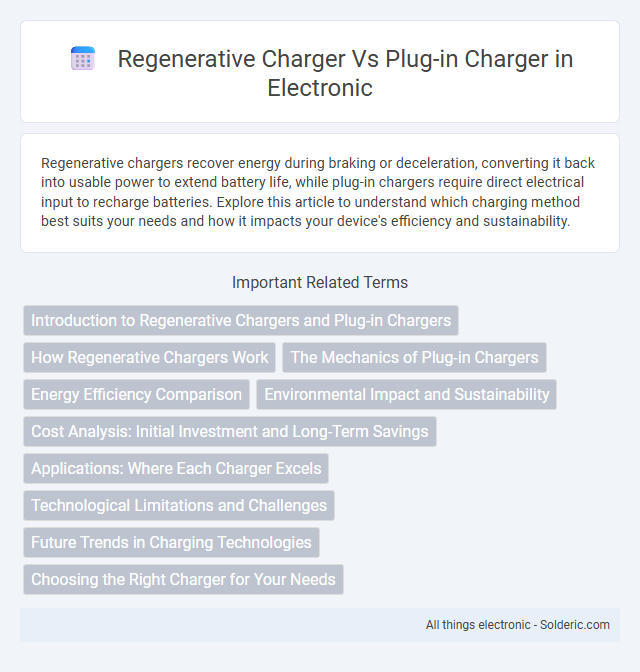Regenerative chargers recover energy during braking or deceleration, converting it back into usable power to extend battery life, while plug-in chargers require direct electrical input to recharge batteries. Explore this article to understand which charging method best suits your needs and how it impacts your device's efficiency and sustainability.
Comparison Table
| Feature | Regenerative Charger | Plug-in Charger |
|---|---|---|
| Energy Source | Kinetic energy recovery (braking, motion) | External electrical grid power |
| Charging Method | Converts mechanical energy to electrical energy during use | Direct connection to power outlet |
| Efficiency | Moderate; dependent on user activity | High; consistent and controlled input |
| Typical Use | Electric/hybrid vehicles, fitness equipment | Electric vehicles, portable electronics, appliances |
| Charging Speed | Slow to moderate; depends on motion | Fast and predictable based on power source |
| Installation | Integrated into device/system | External hardware; plug and play |
| Cost | Higher upfront due to complexity | Lower initial cost |
| Environmental Impact | Reduces waste energy; eco-friendly | Depends on grid energy source |
Introduction to Regenerative Chargers and Plug-in Chargers
Regenerative chargers capture and convert kinetic energy from deceleration or braking into electrical power, recharging the battery efficiently in electric and hybrid vehicles. Plug-in chargers rely on external power sources, such as household outlets or charging stations, to replenish the battery through a direct electrical connection. Both systems enhance energy management but differ in energy acquisition--regenerative chargers utilize motion-based energy recovery while plug-in chargers depend on grid electricity.
How Regenerative Chargers Work
Regenerative chargers capture and convert kinetic energy generated during braking or deceleration into electrical energy for battery storage, enhancing energy efficiency in electric vehicles. By using a motor acting as a generator, these chargers reduce energy waste and increase driving range compared to conventional plug-in chargers that rely solely on external power sources. This process seamlessly integrates energy recovery with standard charging methods, maximizing battery life and sustainability.
The Mechanics of Plug-in Chargers
Plug-in chargers operate by drawing electricity directly from an external power source, converting alternating current (AC) from the grid into direct current (DC) to recharge your vehicle's battery efficiently. The internal charger manages energy flow, ensuring safe voltage levels and optimal charging speed. This direct connection provides consistent power delivery, distinguishing plug-in chargers from regenerative systems that rely on capturing kinetic energy.
Energy Efficiency Comparison
Regenerative chargers recover kinetic energy during braking or deceleration, converting it back into electrical power to recharge the battery, significantly enhancing overall energy efficiency compared to traditional plug-in chargers. Plug-in chargers rely solely on external electrical sources, often resulting in higher grid energy consumption and less efficient energy usage. Integrating regenerative charging systems in electric vehicles reduces energy loss, lowers operational costs, and promotes sustainable energy management.
Environmental Impact and Sustainability
Regenerative chargers reduce environmental impact by capturing and reusing energy during braking or deceleration, enhancing overall energy efficiency and lowering carbon emissions. Plug-in chargers rely entirely on external power sources, which may come from non-renewable energy, potentially increasing your carbon footprint. Choosing regenerative charging systems supports sustainability by maximizing energy conservation and reducing dependence on fossil fuels.
Cost Analysis: Initial Investment and Long-Term Savings
Regenerative chargers typically require a higher initial investment due to their advanced technology and ability to recover and store energy during braking or deceleration. Plug-in chargers have lower upfront costs but lack energy recovery features, leading to higher operational expenses over time. Long-term savings with regenerative chargers often outweigh the initial cost, thanks to reduced electricity consumption and extended battery life, making them more cost-effective for frequent users.
Applications: Where Each Charger Excels
Regenerative chargers excel in applications requiring energy recapture, such as electric vehicles and industrial machinery with frequent braking or stopping, optimizing battery life and energy efficiency. Plug-in chargers are ideal for consistent, stationary charging scenarios like home use, office settings, and public charging stations, providing reliable power replenishment without energy recovery features. Each charger type serves distinct functional roles based on energy flow dynamics and usage environments.
Technological Limitations and Challenges
Regenerative chargers face technological limitations such as lower energy recovery efficiency and complex integration with vehicle systems compared to plug-in chargers, which provide direct, consistent power input with established infrastructure. Challenges include managing variable energy capture during braking and ensuring compatibility with diverse battery chemistries in regenerative systems. Your choice depends on balancing the convenience of plug-in chargers against the innovative, yet sometimes less reliable, energy recapture offered by regenerative technology.
Future Trends in Charging Technologies
Regenerative chargers harness kinetic energy during motion to extend battery life, offering eco-friendly efficiency in electric vehicles, while plug-in chargers rely on direct electrical input for faster, controlled energy transfer. Future trends emphasize integrating smart grid technology and wireless charging infrastructure to enhance convenience and sustainability across charging methods. Your choice between regenerative and plug-in solutions will benefit from advancements in energy recovery systems and real-time charging optimization.
Choosing the Right Charger for Your Needs
Regenerative chargers efficiently capture and store energy generated during braking or deceleration, making them ideal for electric vehicles aiming to maximize battery life and energy use. Plug-in chargers provide a direct power source, offering faster charging speeds and convenience when access to external power outlets is available. Your choice depends on whether you prioritize energy recovery for extended range or quick, reliable recharging from a fixed location.
regenerative charger vs plug-in charger Infographic

 solderic.com
solderic.com